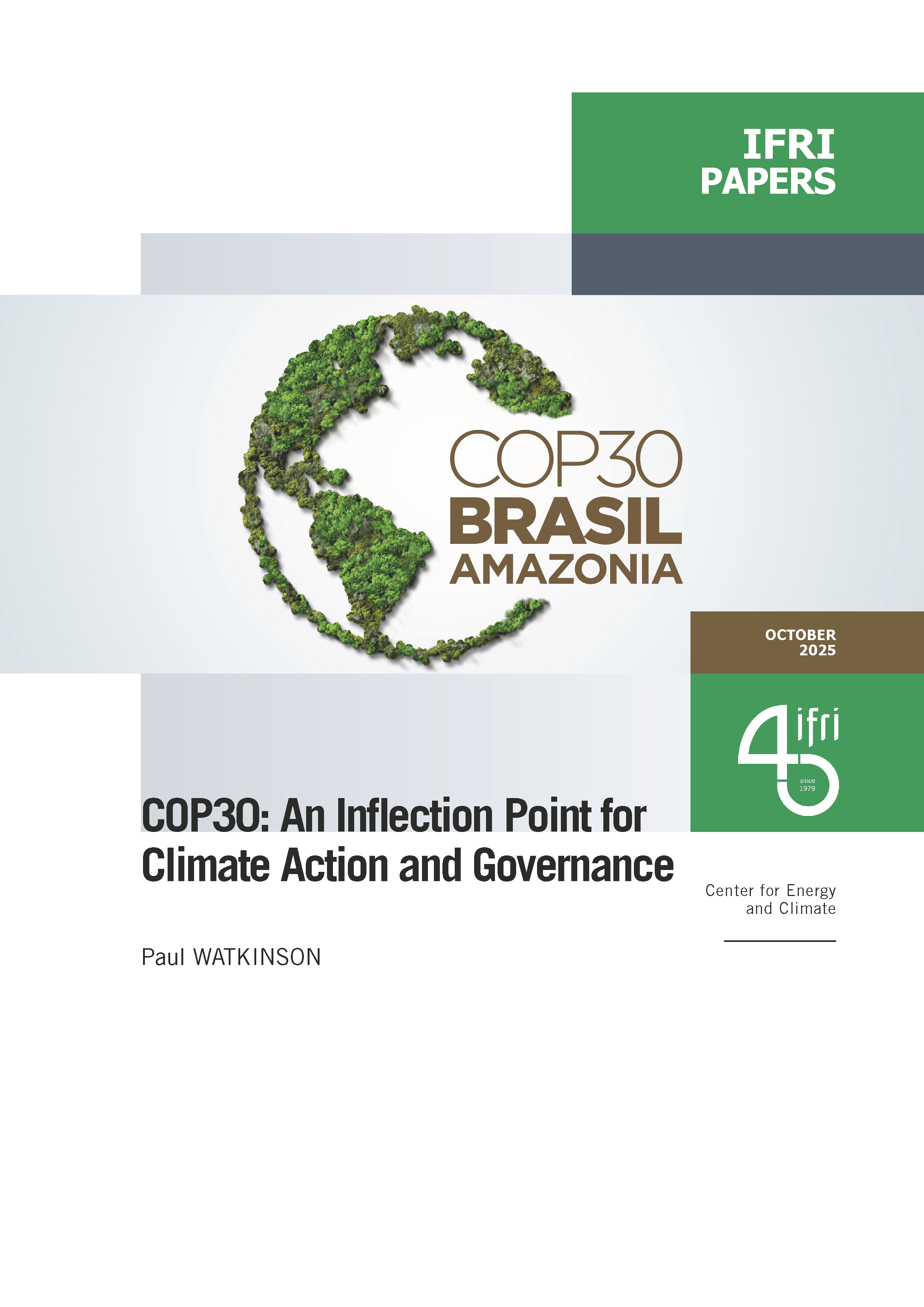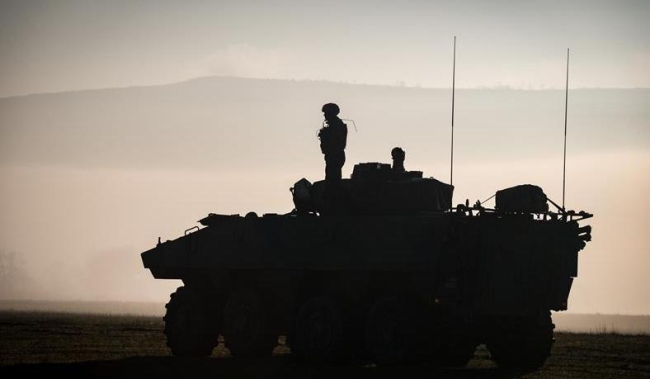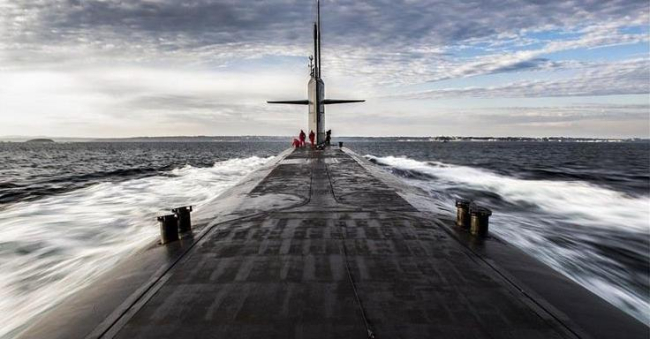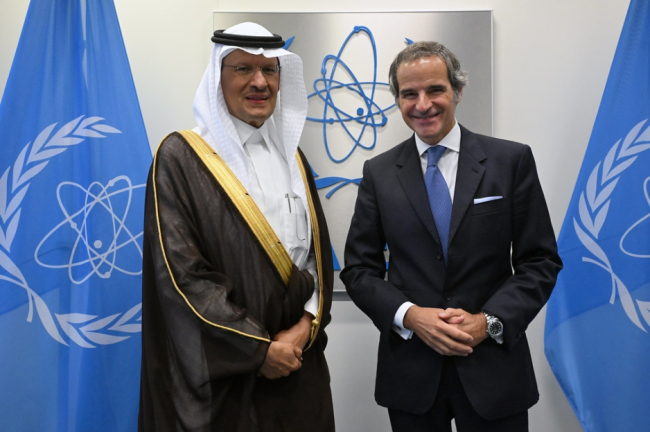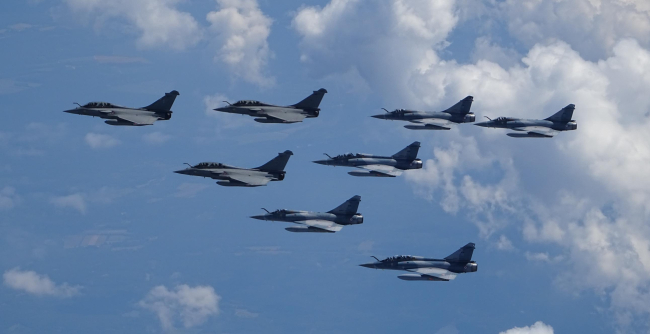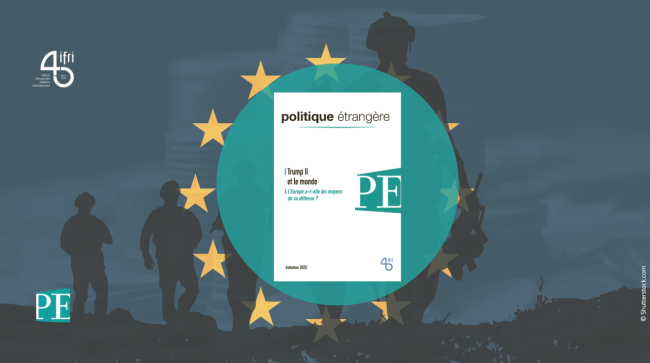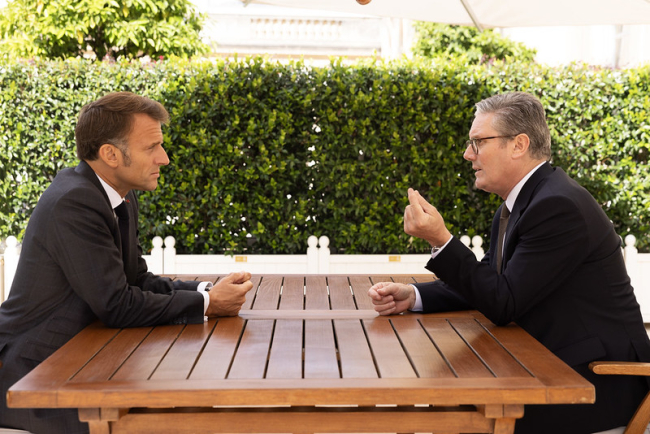The European Equation of Nuclear Deterrence, Variables and Possible Solutions
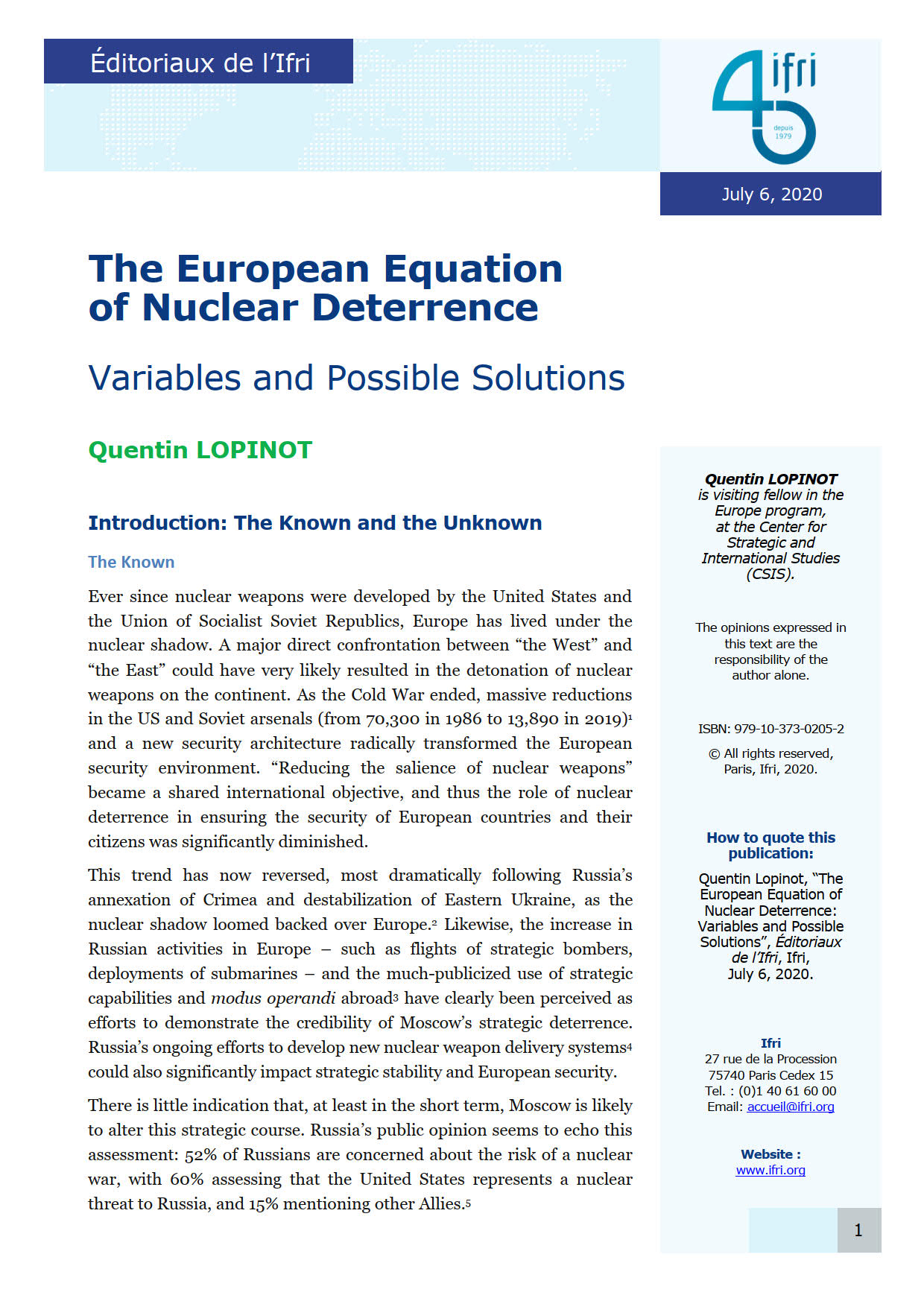
Ever since nuclear weapons were developed by the United States and the Union of Socialist Soviet Republics, Europe has lived under the nuclear shadow. A major direct confrontation between “the West” and “the East” could have very likely resulted in the detonation of nuclear weapons on the continent. As the Cold War ended, massive reductions in the US and Soviet arsenals (from 70,300 in 1986 to 13,890 in 2019) and a new security architecture radically transformed the European security environment.
Introduction - The Known and the Unknown
The Known
Ever since nuclear weapons were developed by the United States and the Union of Socialist Soviet Republics, Europe has lived under the nuclear shadow. A major direct confrontation between “the West” and “the East” could have very likely resulted in the detonation of nuclear weapons on the continent. As the Cold War ended, massive reductions in the US and Soviet arsenals (from 70,300 in 1986 to 13,890 in 2019[1]) and a new security architecture radically transformed the European security environment. “Reducing the salience of nuclear weapons” became a shared international objective, and thus the role of nuclear deterrence in ensuring the security of European countries and their citizens was significantly diminished.
This trend has now reversed, most dramatically following Russia’s annexation of Crimea and destabilization of Eastern Ukraine, as the nuclear shadow loomed backed over Europe[2]. Likewise, the increase in Russian activities in Europe – such as flights of strategic bombers, deployments of submarines – and the much-publicized use of strategic capabilities and modus operandi abroad[3] have clearly been perceived as efforts to demonstrate the credibility of Moscow’s strategic deterrence. Russia’s ongoing efforts to develop new nuclear weapon delivery systems[4] could also significantly impact strategic stability and European security.
There is little indication that, at least in the short term, Moscow is likely to alter this strategic course. Russia’s public opinion seems to echo this assessment: 52% of Russians are concerned about the risk of a nuclear war, with 60% assessing that the United States represents a nuclear threat to Russia, and 15% mentioning other Allies[5].
The Unknown
Russia’s violation of the INF Treaty has raised the possibility of a return of land-based intermediate-range missiles in Europe. If Russia were to massively deploy such systems that could hold at risk the European territory without threatening the US territory, it would represent a significant political and military challenge for the Alliance. NATO has consistently refused to deploy similar capabilities that would mirror Moscow’s violation and bring political tensions to alliance cohesion with little military benefits. However, Allies may continue to consider appropriate measures to maintain the credibility of NATO’s posture – such as reinforcing its conventional forces, enhancing the survivability of its critical infrastructures (most critically those necessary to execute NATO’s nuclear mission), or adapting its missile defense capabilities.
More broadly, the end of the “arms control era” would significantly degrade the security environment of the Allies. This is best illustrated by the Europeans’ vivid concerns about Washington’s stance towards arms control, including major arrangements which have proved to be crucial components of strategic stability in Europe – such as the New START treaty, due to expire on February 5, 2021, or the Open Skies Treaty, which Washington will withdraw from in November 2020.
In this environment, European and North American Allies must decide how they should best adapt their posture to maintain their level of security. Although the answer can only be complex, this paper will focus on the role of nuclear deterrence in European security, and examine different options that Europeans ought to consider.
Four Variables of the European Deterrence Equation
The 2018 NATO Summit Declaration[6] contains something of a formula which synthesizes the role of nuclear deterrence in European security:
The strategic forces of the Alliance, particularly those of the United States, are the supreme guarantee of the security of Allies. The independent strategic nuclear forces of the United Kingdom and France have a deterrent role of their own and contribute significantly to the overall security of the Alliance. These Allies’ separate centres of decision-making contribute to deterrence by complicating the calculations of potential adversaries. NATO's nuclear deterrence posture also relies on United States' nuclear weapons forward-deployed in Europe and the capabilities and infrastructure provided by Allies concerned.
These four sentences are akin to variables whose values are susceptible to evolve, positively or negatively.
First Variable: the strategic coupling of US and European security interests.
This variable could be negatively impacted by political transformations – mainly the development of isolationist policies which would further question the value of collective defense and US extended deterrence. A weaker commitment from Washington towards European security could be seen by potential adversaries as an opportunity to take aggressive actions against Europe without suffering the consequences of a US response. Potential reinforcements of European armed forces and strengthened cooperation could partially compensate this evolution, but these could not match the loss of the “supreme guarantor” of European security.
This variable could be positively impacted by a renewed expression of the indivisibility of US and European security interests. In theory, potential additional US forces or capabilities in Europe can contribute to that end; but it is first and foremost a political commitment that is required. By investing more – financially and politically – in their own security and proving that they are both able and willing to take more responsibilities, European Allies can also contribute to renewing this political commitment, particularly in the post-COVID-19 era.
Second Variable: the contribution of the British and French nuclear deterrents.
This variable could be negatively impacted by decisions to not support modernization efforts of British and French nuclear capabilities. Ultimately, this could compromise the credibility of both countries’ deterrents, which would affect not only their security but also that of the Alliance. The fact that two Allies in addition to the US are also nuclear-weapon states fundamentally alters the balance of force between NATO and its adversaries – even outside of the nuclear realm. As John Mearsheimer noted, “nuclear weapons not only work to shore up deterrence in specific crises, but they also condition the way the superpowers think about dealing with each other”[7].
This variable could be positively impacted by doctrinal orientations through which London and Paris would further underline the contribution of their independent national deterrents to collective deterrence. Most notably, the French President has recently clarified that “France’s vital interests now have a European dimension” [8] – which, contrary to undesirable and unrealistic calls for some sort of European deterrent[9], furthers a consistent evolution towards recognizing that the French nuclear forces play a role in European security beyond national borders. It is worth noting that the speech does not define unilaterally this role, and instead offers to European partners to discuss it collectively.
Third Variable: the existence of various decision-making centers which complicate the adversary’s calculus.
This variable could be negatively impacted by attempts to fully integrate British and French national forces into NATO’s nuclear posture. There is indeed a mosaic of nuclear deterrence in Europe, with NATO’s own nuclear deterrent resting on US weapons and European aircraft, an independent British deterrent contributing to Alliance security and the defence of NATO allies[10], and an independent French one contributing to European and Alliance security[11]. “Rationalizing” this configuration would defeat the purpose of having different decision-making centers, useful to complicate the adversary’s evaluation of the consequences of its actions.
This variable could be positively impacted by London and Paris regularly reaffirming their commitment to the Alliance, the independent nature of their national nuclear deterrents, and the unique overlap between their vital interests. President Macron recently recalled that the French nuclear forces “also significantly contribute to the overall strengthening of the Atlantic Alliance’s overall deterrent”[12]. The upcoming anniversary of the Lancaster House Treaty will also provide an opportunity for London and Paris to reaffirm their strategic relation, in spite of Brexit, and that they “do not see situations arising in which the vital interests of either Party could be threatened without the vital interests of the other also being threatened”[13].
Fourth Variable: the central role of US nuclear weapons in Europe as part of NATO’s nuclear sharing.
This variable could be negatively impacted by domestic political factors, most notably challenges to nuclear deterrence in countries hosting such weapons. All Allies have firmly rejected the Treaty on the Prohibition of Nuclear Weapons[14], but if domestic political circumstances were to alter their positions, it could severely affect the credibility of NATO’s posture. In addition, the adoption of a “No First Use” policy by the United States would risk significantly undermining NATO’s nuclear deterrent[15], since it could signal that an adversary taking the upper hand in a conventional aggression against European Allies could go unchallenged.
This variable could be positively impacted by decisions to modernize the B-61 nuclear weapons[16] and dual capable aircraft in Europe – which would constitute both a political and financial commitment to maintain NATO’s nuclear deterrence. Likewise, Allies taking part in NATO’s nuclear mission should make further efforts to explain the contribution of deterrence to their security in order to build political and public opinion support that would in turn reinforce the credibility of the Alliance nuclear posture.
Four Possible Solutions to the European Deterrence Equation
To strengthen NATO’s deterrence posture, Allies should seek to positively weigh on these four identified variables. To that end, four lines of effort, closely interrelated, could be pursued.
Reinforcing NATO’s commitment to nuclear deterrence as the ultimate guarantee of its security.
Since 2014, Allies have responded to Russia’s actions by reasserting the credibility and central role of nuclear deterrence in their posture, notably making clear at the 2016 Warsaw Summit that “NATO has the capabilities and resolve to impose costs on an adversary that would be unacceptable and far outweigh the benefits that any adversary could hope to achieve”. It is important that all Allies convey systematically the same sense of determination. It is also essential that Allies taking part in NATO’s Nuclear Planning Group match words with deeds and take appropriate national decisions to sustain the Alliance’s posture. This should notably cover the renewal of Dual Capable Aircrafts, efforts to modernize and secure basing infrastructures, and taking more responsibility towards their public opinion for such decisions. Some countries might be tempted to leave NATO’s nuclear sharing arrangements, while some others might be interested in joining, both for political considerations. But such changes are likely to open controversial debates and undermine the Alliance’s posture – at least if they are not prepared in a thorough and multilateral manner.
Maintaining the strength of the transatlantic link, and of intra-European solidarity.
This of course requires that Washington continues to provide NATO with capabilities, personnel and resources required to maintain its nuclear posture, but also reaffirms its political commitment to the Alliance and to European security, which is the bedrock of NATO’s credibility and cannot be compensated by whatever force or capability. The willingness of European partners to pick up on France’s offers to participate in nuclear exercises and to engage in a discussion on the European dimension of its national deterrent will be a first test of a reinvigorated intra-European solidarity. Reversely, it is necessary that European Allies step up their efforts and assume more responsibilities for their security, in order to support the US commitment in the new security environment – one in which the top priority area of this administration, and most likely any next one, will be Asia, and in which the freedom of the global commons should not be taken for granted.
Engaging a European effort to better understand nuclear deterrence and strategic stability dynamics – and “own” their consequences.
For various historical or political reasons, many European Allies have been reluctant to recognize the specific nature of nuclear deterrence, and to acknowledge its contribution to their security. As Europeans face renewed nuclear and conventional risks as well as political challenges to the transatlantic relationship, it is not sustainable to continue viewing nuclear weapons as an “inconvenient truth”. This is in no way incompatible with Europe’s long-standing support for nuclear disarmament – on the contrary, a proactive effort to better understand and acknowledge the importance of nuclear deterrence should go together with further engagement in favor of arms control and disarmament. European citizens might be more aware of this complex reality than often assumed: a recent survey showed that, while remaining overwhelmingly committed to nuclear disarmament, “two-thirds of EU countries believe that nuclear deterrence makes Europe more or much more secure”[17].
Developing a new arms control agenda that more directly takes into account European security interests.
The ongoing demise of arms control has a direct and unique impact on the security of European countries. They are uniquely positioned, both geographically and politically, to denounce any attempt to consider nuclear weapons as battlefield weapons, to develop destabilizing new systems, and to disregard or violate existing arms control arrangements. But they cannot wait passively for the outcome of US-Russia strategic dialogues, or the absence thereof, and should actively engage in a collective exercise to identify their specific concerns and push for a new agenda on arms control, strategic risks reduction and transparency that would fully support their security interests[18].
[2]. “Ukraine conflict: Putin 'was ready for nuclear alert'”, BBC, 15 March 2015, available on: www.bbc.com
[6]. Cf. para. 35https://www.nato.int/cps/en/natohq/official_texts_156624.htm
[7]. J. J. Mearsheimer, “Nuclear Weapons and Deterrence in Europe.” International Security, vol. 9, no. 3, 1984, pp. 19–46.
[8]. Speech of the President of the Republic on the Defense and Deterrence Strategy, 7 February 2020, available on: www.elysee.fr.
[9]. „Wir sollten uns an nuklearer Abschreckung beteiligen“, Der Tagesspiegel, 2 February 2020, available on: www.tagesspiegel.de.
[10]. Strategic Defence and Security Review, 23 November 2015, available on: assets.publishing.service.gov.uk
[11]. Speech of the President of the Republic, 7 February 2020 , op. cit.
[12]. Ibid.
[13]. Treaty between the United Kingdom of Great Britain and Northern Ireland and the French Republic for Defence and Security Co-operation, 2 November 2010, available on: assets.publishing.service.gov.uk.
[14]. North Atlantic Council Statement on the Treaty on the Prohibition of Nuclear Weapons, 20 September 2017, available on: www.nato.int.
[15]. I. King, “A commitment to never use nuclear weapons first will not make us safer”, The Hill, 26 December 2019, available on: thehill.com.
[16]. United States Government Accountability Office, “B61-12 Nuclear Bomb: Cost Estimate for Life Extension Incorporated Best Practices, and Steps Being Taken to Manage Remaining Program Risks”, May 2018, available on: www.gao.gov.
[17]. M. Lafont Rapnouil, T. Varma, N. Witney, “Eyes Tight Shut: European Attitudes Towards Nuclear Deterrence”, ECFR, 2018, available on: www.ecfr.eu.
[18]. C. Brustlein, “The Erosion of Strategic Stability and the Future of Arms Control in Europe”, IFRI Proliferation Papers, November 2018, available on: www.ifri.org.

Available in:
Regions and themes
ISBN / ISSN
Share
Download the full analysis
This page contains only a summary of our work. If you would like to have access to all the information from our research on the subject, you can download the full version in PDF format.
The European Equation of Nuclear Deterrence, Variables and Possible Solutions
Related centers and programs
Discover our other research centers and programsFind out more
Discover all our analysesSaudi Arabia’s Nuclear Temptations. Lessons Learned from Regional Instability
Saudi Arabia’s integration in the international arena and regional stability, notably through reducing its dependence on fossil energies, are crucial elements for the success of the Kingdom’s Vision 2030, the Crown Prince’s top priority. However, Mohammed bin Salman’s declarations in 2018 and 2021, indicating that “if Iran develops a nuclear bomb, we will follow suit as soon as possible”, combined with the recent strikes on key Iranian nuclear facilities, do not bode well for the future of the Kingdom, the region and the non-proliferation regime at large.
The Future of Air Superiority. Command of the Air in High Intensity Warfare
Air superiority, understood as control of the air, is a cornerstone of the Western art of warfare. It is a decisive condition, albeit not sufficient by itself, to achieve military victory, as it enables the concentration of air power toward the achievement of wider strategic objectives and protects other components from unbearable attrition levels. It is best achieved through the offensive use of air power in a joint effort to neutralize the enemy’s air power.
Europe Uncovered?
As Russia continues to threaten Europe, the Trump administration is making no secret of its desire to withdraw—at least partially—from the defense of the Old
Continent in order to focus on strategic competition with China. It is thus putting pressure on its European allies to increase their investment in the military sector. The NATO Summit in The Hague in June 2025 resulted in ambitious commitments by member states to increase their defense spending.
How should Britain and France cooperate to realise the Northwood Declaration?
During his state visit to the United Kingdom (UK) last week, Emmanuel Macron, President of France, signed a joint declaration with Sir Keir Starmer, Prime Minister, on nuclear cooperation between Britain and France. The Northwood Declaration highlights that while both countries’ nuclear arsenals remain sovereign, cooperation on nuclear deterrence can ‘contribute significantly’ to the security of the North Atlantic Treaty Organisation (NATO) and the Euro-Atlantic region.



